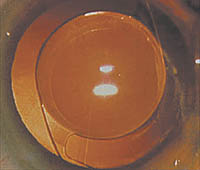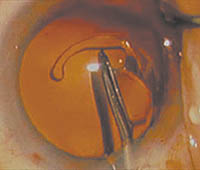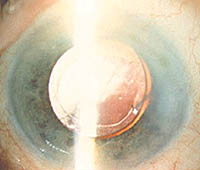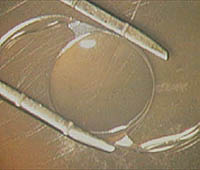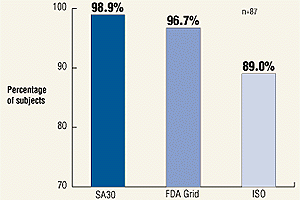Global results with single-piece AcrySof indicate good centration and low PCO rate
The single-piece AcrySof gives a comparable performance to the multi-piece AcrySof.
VIENNA, Austria — Global clinical results for the recently Food and Drug Administration (FDA) approved single-piece AcrySof SA30 (Alcon, Fort Worth, Texas) IOL are highly encouraging.
“I think the most important feature of the lens is that it is all one piece. The AcrySof has been shown to be the most biocompatible of any IOL material,” said Stephen F. Brint, MD, medical director of the Eye Surgery Center of Louisiana in New Orleans and one of the clinical investigators. “The strength and memory of the haptics also are superior to any other haptic material, including PMMA. This allows the AcrySof to be stretched, pulled or deformed — even through an injecting instrument — with no potential damage to the haptics.” In essence, “one size fits all. The haptics extend to the equator of the capsular bag perfectly and keeps the lens beautifully centered.” Dr. Brint also believes that, in general, soft acrylic IOLs fit better than silicone IOLs.
The global study consisted of 330 lenses: 148 implanted in the United States and 182 in Europe. There were five U.S. investigators and 11 international investigators. All cataractous patients were at least 60 years old and underwent phacoemulsification with capsular bag placement of the lens. One-year follow-up data (11 to 14 months) for 129 U.S. patients and 18 European patients were presented by Dr. Brint here at the annual meeting of the European Society of Cataract and Refractive Surgeons.
Impressive visual acuity
Best corrected distance visual acuity was 20/40 or better at 1 year for 96.9% of 129 American subjects. “This percentage far exceeds the FDA grid of 92.5% and the European ISO grid of 81%,” Dr. Brint said. In addition, the best-case (excluding pathologies) best corrected distance visual acuity at 1 year was 20/40 or better for 98.9% of 87 patients.
The investigators found no significant complications, including no clinically significant IOL complications, no lens-related adverse events and no lens tilt or decentration. “One of the highlights of this lens that has made it so outstanding is the fact that the material renders the capsular bag basically inert; therefore, there is no capsular phimosis,” explained Dr. Brint, an associate clinical professor of ophthalmology at Tulane University School of Medicine in New Orleans.
Dr. Brint also is pleased with the low posterior capsular opacification (PCO) rate. A recent study of autopsy eyes by David Apple, MD, revealed that over an 11-year period (January 1988 to April 1999), less than 2% of AcrySof eyes (two out of 128) had undergone Nd:YAG capsulotomy. The next closest lenses had a capsulotomy rate greater than 8% (two out of 24). The Apple study, along with several others, suggests that the “AcrySof lens has a capsulotomy rate of 2% at 3 years, compared with about 20% with either silicone or PMMA, and about 40% with the new hydrogel [Hydroview; Bausch & Lomb Surgical, Claremont, Calif.] lens,” Dr. Brint said.
The AcrySof’s low PCO rate is due to a combination of material, design and surgical technique, Dr. Brint said. “The edge design tends to act as a barrier for epithelial cells migrating under the lens.”
Fibrosis low
A 1998 study by Carlos Figuereido, MD, compared capsular contraction and fibrosis at 6 months for three lenses: the AcrySof MA60BM, the STAAR AA4203 (a one-piece plate haptic silicone design) and the Allergan SI30 (a three-piece silicone design). Overall, “95% of the AcrySof lenses resulted in no contraction,” Dr. Brint said, versus 40% with the STAAR and 35% with the Allergan. Likewise, 60% of the STAAR lenses contracted 1 to 2 mm and 65% of the Allergan lenses contracted 2 to 4 mm, “where as none of the AcrySof lenses contracted 2 to 4 mm,” he said. Fibrosis of +3 and +4 also was absent with the AcrySof, but was 70% with the two other lenses.
A post opuveitis study summary of 100 eyes for each material indicates that acrylic has a 2% grade 1 uveitis rate compared with 14% with silicone. Treating with prescription reduced the acrylic to 1%, but still rendered silicone 9%. There also were two toxic silicone lenses.
The AcrySof is ultraviolet absorbing and has a refractive index of 1.55. Plus, it can be inserted using a variety of techniques. “You can use either several different types of forceps or several different types of injectors,” Dr. Brint said. “Now that this one-piece design has finally been approved, I think it will become the lens of choice for most cataract surgeons.”
|
|
|
|
|
|
|
| |
Range of capsular bag diameters | |
Overall best distance visual acuities (U.S.) | |
Best-case distance visual acuities (U.S.) | |
For Your Information:
- Stephen F. Brint, MD, can be reached at the Eye Surgery Center of Louisiana, 3901 Veterans Blvd., Metairie, LA 70002; (504) 888-2020; fax: (504) 887-8166. Dr. Brint has no direct financial interest in any of the products mentioned in this article, nor is he a paid consultant for any companies mentioned.
- Alcon can be reached at 6201 South Freeway, Fort Worth, TX 76134; (800) 862-5266; fax: (817) 241-0677.
- Bausch & Lomb Surgical can be reached at 555 W. Arrow Highway, Claremont, CA 91711; (800) 423-1871; fax: (909) 399-1525.
- STAAR Surgical Co. can be reached at 1911 Walker Ave., Monrovia, CA 91016; (818) 303-7902; fax: (818) 358-9187

